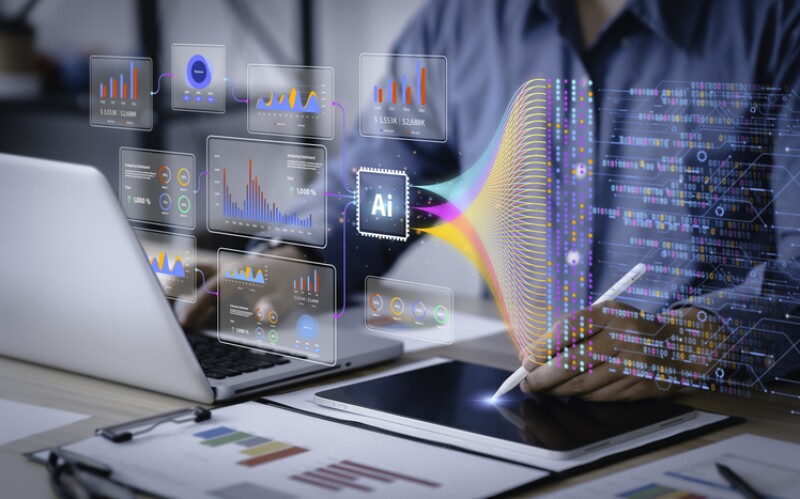The Stanford Institute Human-Centered Artificial Intelligence recently released the eighth edition of its AI Index Report. The report offers a comprehensive, data-driven view of AI and equips policymakers, business leaders, and the public with insights into AI’s technical progress, economic influence, and societal impact.
AI’s accelerated adoption rate, generative AI startups, and policymakers' investment are among the topics covered.
“AI is no longer just a story of what’s possible—it’s a story of what’s happening now and how we are collectively shaping the future of humanity,” said AI Index Report codirectors, Yolanda Gil and Raymond Perrault.
1. AI performance on benchmarks continues to improve.
In 2023, several new benchmarks were introduced by researchers to test the limits of advanced AI. These benchmarks include massive multidiscipline multimodal understanding (MMMU) which comprises around 11,500 college-level questions from six core disciplines and is, according to the report, “among the most demanding tests of perception, knowledge, and reasoning in AI to date. AI is increasingly embedded in everyday life.”
Researchers also introduced the graduate-level Google-proof Q&A (GPQA) which consists of 448 difficult multiple-choice questions that cannot be easily answered by web search and the SWE-bench, a dataset comprising 2,294 software engineering (SWE) problems sourced from real GitHub issues and popular Python repositories.
The 2024 report also showed an increase in AI video generation with several video-generation systems helping to advance the technology including, Sora, Gen-3 Alpha, and Meta’s Movie Gen.
2. Business is "all in" on AI, fueling record investment and usage, as research continues to show strong productivity impacts.
According to the report, “US private AI investment hit $109.1 billion in 2024, nearly 12 times higher than China’s $9.3 billion and 24 times the UK’s $4.5 billion.” These numbers vary with generative AI where US investment exceeded the combined total of China and the EU plus the UK by $25.4 billion.
Corporate AI investment reached $252.3 billion in 2024, with total investment growing more than thirteenfold since 2014.
Just as investment rose, the use of AI also showed a steady increase to 78% of survey respondents reporting AI use by their organizations, up from 55% in 2023.
3. Global AI optimism is rising—but deep regional divides remain.
Asian countries led the way in viewing AI positively, with China (83%), Indonesia (80%), and Thailand (77%) seeing more benefits than harm.
This is in sharp contrast to responses in Canada (40%), the US (39%), and the Netherlands (36%).
The data also revealed a divide in how countries view AI’s impact on the job market and their personal careers. For example, Poland expressed low optimism in both aspects with 17 and 21%, respectively. China, on the other hand, expressed optimism in both with 44% believing AI will enhance the job market, and 62% thinking it will improve their jobs.
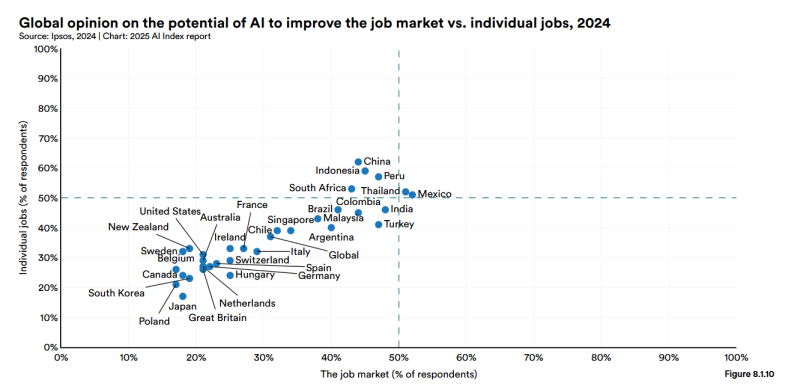
4. Attitudes about AI and its impact on jobs
Using data from Ipsos’s latest survey on AI, respondents’ attitudes toward AI reveal that 60% believe AI is likely to change how they do their job in the next 5 years, and 36%, or more than one in three, believe that AI is likely to replace their current job in the next 5 years.
Gen Z and millennials were more likely than Gen X and boomers to say AI will reshape how they do their jobs in the next 5 years.
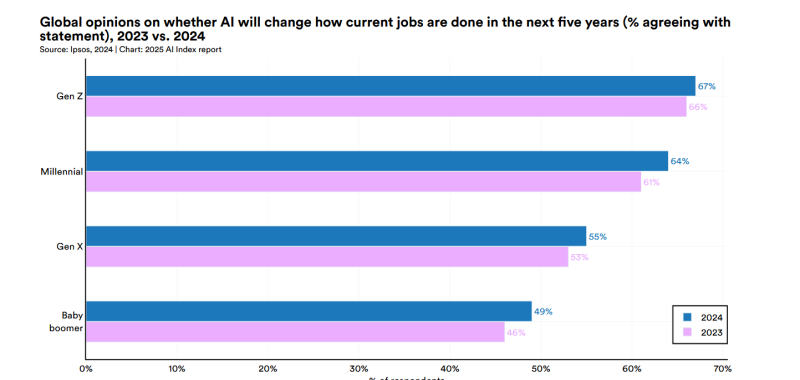
5. AI and computer science education is expanding—but gaps in access and readiness persist.
Access to and enrollment in high school computer science (CS) courses has increased in the US with 81% of CS teachers agreeing that using AI and learning about AI should be included in a foundational CS learning experience. Despite this, less than half of high school CS teachers felt equipped to teach AI.
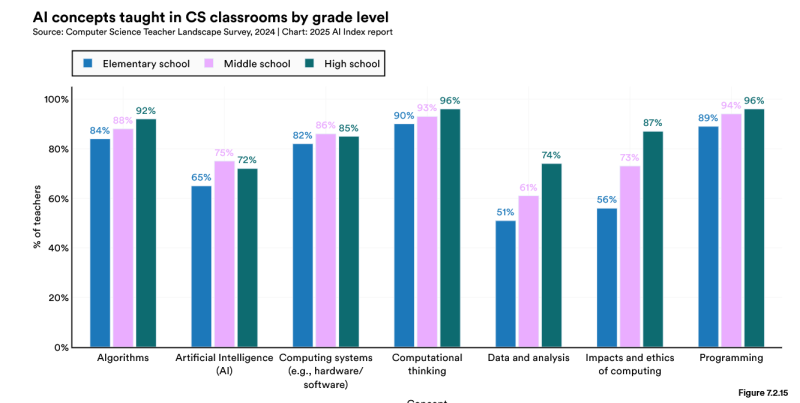
The report also indicates that the number of graduates with bachelor’s degrees in computing has increased 22% over the past 10 years, with master’s degrees in CS seeing a 26% increase between 2022 and 2023, and an overall increase of 83% in the past decade.
Higher education institutions have also seen an increase in AI-specific bachelor’s and master’s degrees with 45 institutions offering a master’s degree and 19 offering bachelor’s degrees.
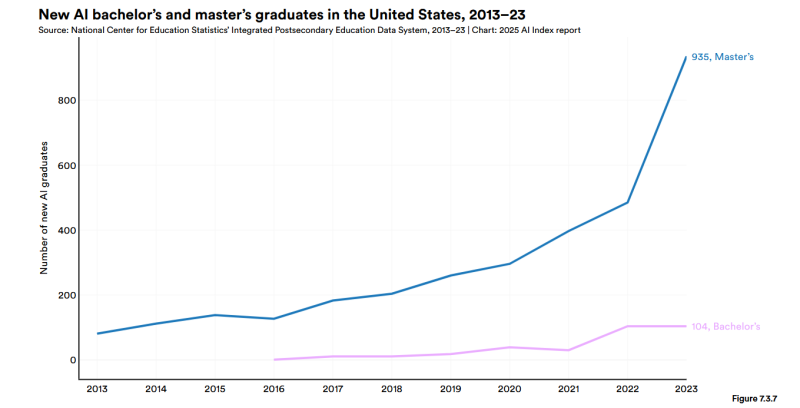
6. Carbon emissions from AI training are steadily increasing.
According to the report, “Despite significant improvements in the energy efficiency of AI hardware, the overall power consumption required to train AI systems continues to rise rapidly.”
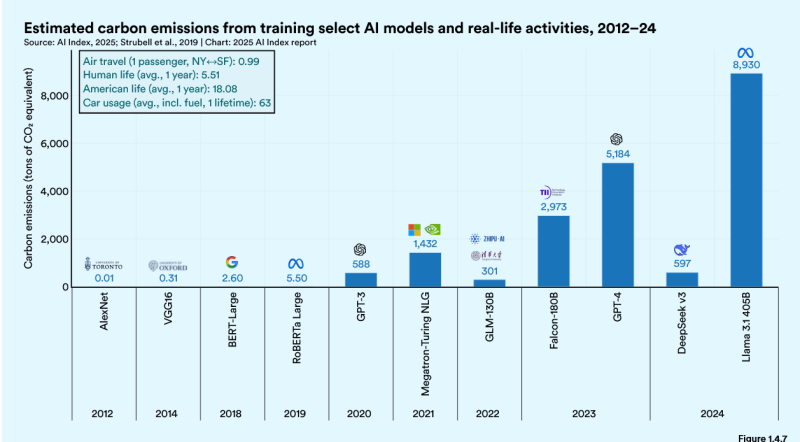
Early training models in 2012 emitted just 0.01 tons of carbon—but by 2020 and beyond, some models have pumped out up to 8,930 tons as seen in the Llama 3.1 405B (2024) model. The average carbon footprint for a person in the US is 16 tons.
“What a year 2024 has been for AI. The recognition of AI’s role in advancing humanity’s knowledge is reflected in Nobel prizes in physics and chemistry and the Turing award for foundational work in reinforcement learning. The once-formidable Turing Test is no longer considered an ambitious goal, having been surpassed by today’s sophisticated systems. Meanwhile, AI adoption has accelerated at an unprecedented rate, as millions of people are now using AI on a regular basis both for their professional work and leisure activities. As high-performing, low-cost, and openly available models proliferate, AI’s accessibility and impact are set to expand even further,” said Gil and Perrault.

